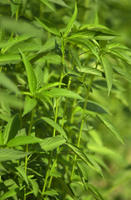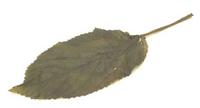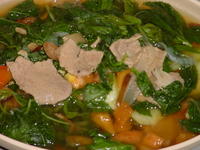
We went shopping yesterday at 99 Ranch Market and bought groceries to cook. We grabbed the usual veggies such as tomatoes, onions, carrots, green onions, head cabbage etc. but this time my wife picked up a bunch of saluyot leaves. She said Tita Jesse cooked some made with bagoong and vinegar as a salad with dried shrimp. Aurora wanted me to cook something similar to that.
I remember growing up and eating dinengdeng everday and that saluyot was a normal part of our Ilocano diet.
I couldn't just cook a plain version of dinengdeng so I added pork, shiitake, and baby bok choy to the dish to make it plentiful. If you haven't tried saluyot I encourage you to try it! When its cooked in soup like this it gets a little slimey in texture like when you eat okra. So ono! So good for you! :) No wonder when I was growing up I used to mix up okra and saluyot thinking that saluyot were the leaves of the okra plant. lol :D
Here is my recipe.
Pork Dinengdeng with Saluyot
Ingredients:
2-3 cups water
1 garlic clove, smashed and minced fine
1/2 round onion, sliced very thin
2-3 Tbsp bagoong isda or harm ha (fine shrimp paste)
1 whole tomato, sliced into thin wedges
6 cups saluyot or jute leaves
2-4 dried shiitake mushrooms, soaked in hot water and sliced thin--save 1 cup of the mushroom water
8 oz of lean pork, sliced very thin
Dash cracked black pepper to taste
Dash MSG to taste (optional)
1-2 Tbsp patis or fish sauce/nuoc mam
3 stalks baby bok choy, rinsed clean and cut into 2x2 pieces
Marinade mixture for pork:
1 tsp tapioca starch
2 Tbsp soy sauce
2 Tbsp Shaoxing wine or whiskey
1/8 inch ginger grated fine
mix well with pork for 20 minutes and set aside.
Procedure:
Boil water with tomatoes, garlic and onions until tomato and onions are soft. Add bagoong sauce. Add in mushrooms and mushroom water and let simmer for 15-20 minutes or until mushroom is soft.
Add marinated pork and cook for 3 minutes. Pork should be cooked through and broth should taste rich and meaty.
Add saluyot, bok choy leaves and continue simmering for 3 minutes.
Season with pepper and add more patis and or bagoong/harm ha for saltiness.
Serve with hot steamed rice.
Serves 4
jute leaf = West Africa sorrel = krin-krin = saluyot = rau day = Jew mallow
Notes: These are tossed into stews in Africa, the Philippines, and Southeast Asia.
Substitutes: spinach

What is Saluyot?
Saluyot is a leafy vegetable popular among Ilocanos in the Philippines. Saluyot is easy to propagate, you can start harvesting the leaves after one month. It is easier to plant saluyot than any other crop since you don't need pesticide and fertilizer to grow the crop.
If you have ½ cup boiled saluyot leaves (45g) for your lunch and dinner, you are assured with 20 kcal for energy, 1.3 g for protein, 0.3 g for fat, 3.1 g for carbohydrate, 0.4 for fiber, 87.3 mg for calcium, 22.5 mg for calcium, 1,334 for beta carotene, 1.0 mg for iron, 0.02 for thiamin, 0.04 mg for riboflavin, 0.3 mg for niacin, and 10 mg for Vitamin C.

Saluyot is rich in beta-carotene for good eyesight, iron for healthy red blood cells, calcium for strong bones and teeth, and vitamin C for smooth, clear skin, strong immune cells, and fast wound healing. In other words, saluyot is a nourishing green leafy vegetable. Secondly, it is the legitimate source of the world's raw materials for containers of rice, corn, sugar, mongo and other commodities.


No comments:
Post a Comment